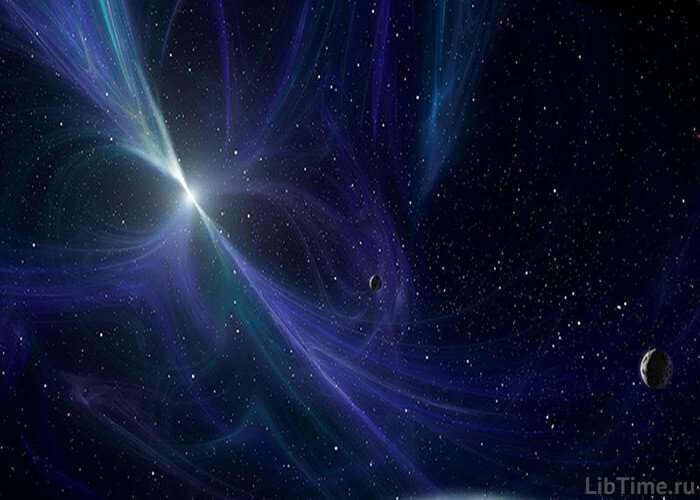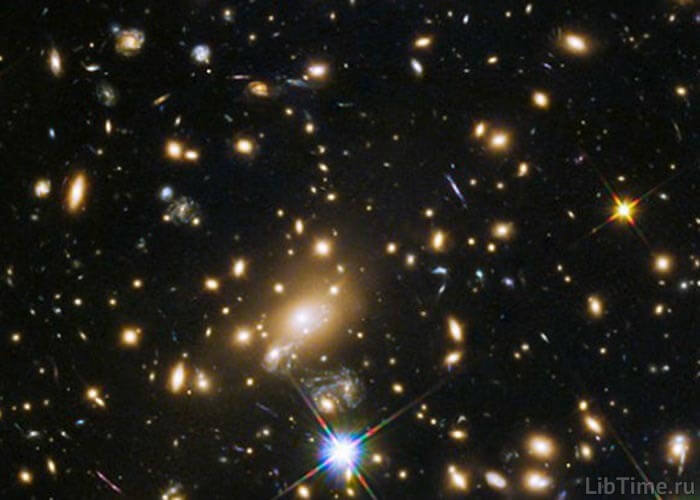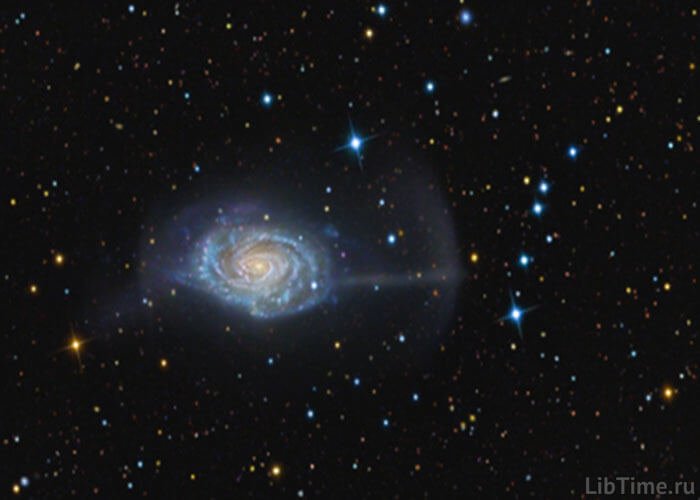Relict radiation from the universe
One of the interesting discoveries related to the electromagnetic spectrum is the relic radiation of the Universe. It was discovered by accident, although the possibility of its existence was predicted.
History of the discovery of relic radiation
The history of the discovery of relic radiation began in 1964. Employees of the American laboratory Bell Telephone were developing a communication system with the help of an artificial Earth satellite. This system was to work on waves of length 7.5 centimeters.
Such short wavelengths for satellite radio communication have some advantages, but until Arno Penzias and Robert Wilson, no one had solved this problem. They were pioneers in this field and had to take care that there was no strong interference on the same wavelength, or that the communicators knew about such interference in advance.
At that time it was thought that the source of radio waves coming from space could only be point objects like radio galaxies or stars.
The scientists had at their disposal an exceptionally accurate receiver and a rotating horn antenna. With these, scientists could listen to the entire sky in much the same way that a doctor listens to a patient's chest with a stethoscope.
A signal from a natural source
And now, as soon as the antenna was pointed at one of the points of the sky, as the oscilloscope screen danced a curved line. A typical natural source signal. Probably, the experts were surprised by their luck: in the first measured point - the source of radio emission!
But no matter where they pointed their antenna, the effect was the same. The scientists checked the equipment again and again, but it was in good working order. And finally they realized that they had discovered a previously unknown phenomenon of nature: the entire universe was as if filled with radio waves of centimeter length.
If we could see radio waves, the sky would appear to us as glowing from edge to edge.
Penzias and Wilson's discovery was published.
And not only they, but also scientists of many other countries began to search for sources of mysterious radio waves, captured by all adapted for this purpose antennas and receivers, wherever they were and at whatever point in the sky would be aimed, and the intensity of radio emission at a wave of 7.5 centimeters at any point was absolutely the same, it was as if smeared across the sky evenly.
Relict radiation was calculated by scientists
Soviet scientists A. G. Doroshkevich and I. D. Novikov, who predicted relic radiation before its discovery, made the most complicated calculations. They took into account all the available sources of radiation in our Universe, took into account and how the radiation of certain objects has changed over time. And it turned out that in the area of centimeter waves all these radiations are minimal and, therefore, for the detected glow of the sky is not responsible.
Meanwhile, further calculations showed that the density of smeared radiation is very high. Here is a comparison of photon kisel (so called scientists mysterious radiation) with the mass of all matter in the Universe. If all the matter of all visible galaxies is evenly "smeared" over the entire space of the Universe, there will be only one hydrogen atom per three cubic meters of space (for simplicity, we will consider all the matter of stars as hydrogen).
And at the same time, each cubic centimeter of real space contains about 500 photons of radiation. Not much, even if we compare not the number of units of matter and radiation, but directly their masses. Where did such intense radiation come from?
In his time, the Soviet scientist A. A. Friedman, solving the famous Einstein equations, discovered that our universe is in constant expansion. Soon confirmation of this was found. The American E. Hubble discovered the phenomenon of galaxy expansion. Extrapolating this phenomenon into the past, we can calculate the moment when all the matter of the Universe was in a very small volume and its density was incomparably greater than now.
In the course of the expansion of the Universe there is also a lengthening of the wavelength of each quantum proportional to the expansion of the Universe; thus the quantum as if "cools down" - in fact, the smaller the wavelength of the quantum, the "hotter" it is. Today's centimeter radiation has a brightness temperature of about 3 degrees Kelvin absolute scale.
And ten billion years ago, when the Universe was incomparably smaller, and the density of its matter is very large, these quanta had a temperature of about 10 billion degrees. Since then our Universe has been "covered" with quanta of continuously cooling radiation. That is why "smeared" on the Universe centimeter radio emission and received the name of relic radiation.
Relics, as it is known, are the remains of the most ancient animals and plants, preserved to our days. Quanta of centimeter radiation is certainly the oldest of all possible relics. In fact, their formation dates back to an epoch about 15 billion years from us.
Knowledge of the Universe brought relic radiation
Practically nothing can be said about what was the substance at the zero moment, when its density was infinitely large. But the phenomena and processes that took place in the Universe, just a second after its birth and even earlier, up to 10~8 seconds, scientists already have a pretty good idea. It was the relic radiation that brought this information.
So, a second had passed since the zero moment. The matter of our Universe had a temperature of 10 billion degrees and consisted of a kind of "porridge" of relic quanta, electrodes, positrons, neutrinos and antineutrinos. The density of the "porridge" was huge - more than a ton per each cubic centimeter. In such "crowded" collisions of neutrons and positrons with electrons, protons were transformed into neutrons and vice versa.
But it was the quanta that were most abundant here - 100 million times more than neutrons and protons. Of course, at this density and temperature, no complex nuclei of matter could exist: they did not decay here. A hundred seconds passed. The Universe continued to expand, its density continuously decreasing, its temperature falling.
Positrons almost disappeared, neutrons turned into protons. The atomic nuclei of hydrogen and helium began to form. Calculations made by scientists show that 30 percent of neutrons united to form helium nuclei, while 70 percent of them remained lonely and became hydrogen nuclei. In the course of these reactions there were new quanta, but their quantity was no longer in any comparison with the original, so it can be considered that it did not change at all.
The expansion of the Universe continued. The density of the "porridge", so steeply brewed by Nature at the beginning, decreased proportionally to the cube of linear distance. Years, centuries, millennia passed. Three million years passed. The temperature of the "porridge" by this time had fallen to 3-4 thousand degrees, the density of matter also approached the one known to us today, but clots of matter from which stars and Galaxies could be formed, could not arise yet.
Too great was the radiant pressure at that time, pushing any such formation apart. Even helium and hydrogen atoms remained ionized: electrons existed separately, protons and atomic nuclei - also separately. Only by the end of the three-million-year period in the cooling "porridge" began to appear the first thickening. They were very few at first.
Barely one thousandth of the "porridge" condensed into peculiar protostars, as these formations began to "burn" similarly to modern stars. And the photons and quanta of energy emitted by them heated up the "porridge", which had begun to cool down, to temperatures at which the formation of new lumps was again impossible. Periods of cooling and re-heating of the "porridge" by flashes of protostars alternated with each other.
And at some stage of the expansion of the Universe, the formation of new condensations became almost impossible because the once so thick "porridge" became too "liquefied". About 5 percent of matter had time to unite, and 95 percent dispersed in the space of the expanding Universe. This is how the once hot quanta that formed the relic radiation "scattered".
The nuclei of hydrogen and helium atoms, which were part of the "porridge", were scattered in the same way.
Hypothesis for the formation of the Universe
Here is one of the hypotheses of the formation of the Universe: most of the matter of our Universe is not in the composition of planets, stars and galaxies, but forms intergalactic gas - 70 percent of hydrogen and 30 percent of helium, one hydrogen atom per cubic meter of space.
Then the development of the Universe passed the stage of protostars and entered the stage of matter ordinary to us, ordinary unfolding spiral Galaxies, ordinary stars, the most familiar of which is our Sun.
Around some of these stars formed systems of planets, at least on one of these planets arose life, in the course of evolution gave rise to intelligence. How often there are in the vastness of space stars, surrounded by a round dance of planets, scientists do not yet know. Nor can they say anything about how often life arises on the planets.
And the question of how often the plant of life blossoms with the lush flower of reason, remains open. The hypotheses known to us today, treating all these questions, are more like ill-founded guesses. But today science develops avalanche-like.
More recently, scientists had no idea how our universe began. Discovered about 70 years ago, relic radiation made it possible to paint that picture. Today, mankind lacks the facts on which to base an answer to the questions formulated above.
Penetration into outer space, visits to the Moon and other planets, bring new facts. And the facts are followed not by hypotheses, but by rigorous conclusions.
Relict radiation tells us that the Universe is homogeneous.
What else have told scientists relic rays, these witnesses to the birth of our universe? A. A. Friedman solved one of the equations given by Einstein, and on the basis of this solution discovered the expansion of the universe.
In order to solve Einstein's equations, it was necessary to set the so-called initial conditions. Friedman proceeded from the assumption that the Universe is homogeneous and isotropic, that matter in it is distributed uniformly. And during 5-10 years that have passed since Friedman's discovery, the question of whether his assumption was correct remained open.
Now it is essentially removed. The isotropy of the Universe is evidenced by the amazing uniformity of relic radio emission. The second fact testifies to the same - the distribution of the substance of the Universe between Galaxies and intergalactic gas.
Indeed, the intergalactic gas, which constitutes the bulk of the matter of the Universe, is distributed over it as uniformly as the relic quanta. The discovery of relic radiation provides an opportunity to look not only into the ultra-distant past - beyond the limits of time, when there was neither our Earth, nor our Sun, nor our Galaxy, nor even the Universe itself.
Like a marvelous telescope that can be pointed in any direction, the discovery of relic radiation allows us to look into the ultra-distant future. Such a super distant future, when there will be neither the Earth, nor the Sun, nor the Galaxy.
Here will help the phenomenon of the expansion of the Universe, the way the stars, galaxies, dust and gas clouds that compose it are flying apart in space. Is this process eternal? Or will the expansion slow down, stop, and then be replaced by compression? And are not the successive compressions and expansions of the Universe peculiar pulsations of matter, indestructible and eternal?
The answer to these questions depends first of all on how much matter is contained in the Universe. If its total gravitation is enough to overcome the inertia of expansion, the expansion will inevitably be replaced by contraction, in which the galaxies will gradually converge. And if the gravitational forces are not enough to brake and overcome the inertia of expansion, our Universe is doomed: it will dissipate into space!
The impending doom of our entire universe! Is there a bigger problem? The study of relic radiation has given science the opportunity to put it. And it is possible that further research will solve it.


